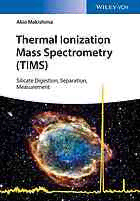
Thermal ionization mass spectrometry (TIMS): silicate digestion, separation, and measurement PDF
Preview Thermal ionization mass spectrometry (TIMS): silicate digestion, separation, and measurement
AkioMakishima ThermalIonizationMass Spectrometry(TIMS) RelatedTitles Gauglitz,G.,Moore,D.S.(eds.) Vanhaecke,F.,Degryse,P.(eds.) HandbookofSpectroscopy IsotopicAnalysis SecondEdition FundamentalsandApplicationsUsing ICP-MS 2013 ISBN:978-3-527-32150-6,alsoavailablein 2012 electronicformat ISBN:978-3-527-32896-3,alsoavailablein electronicformat Lehto,J.,Hou,X. Hübschmann,H. ChemistryandAnalysisof HandbookofGC/MS Radionuclides FundamentalsandApplications LaboratoryTechniquesand ThirdEdition Methodology 2014 2011 PrintISBN:978-3-527-33474-2,alsoavailable ISBN:978-3-527-32658-7,alsoavailablein inelectronicformat electronicformat AkioMakishima Thermal Ionization Mass Spectrometry (TIMS) SilicateDigestion,Separation,andMeasurement Author AllbookspublishedbyWiley-VCH arecarefullyproduced.Nevertheless, Prof.Dr.AkioMakishima authors,editors,andpublisherdonot OkayamaUniversityatMisasa warranttheinformationcontainedin InstituteforStudyoftheEarth’sInterior thesebooks,includingthisbook,to Yamada827 befreeoferrors.Readersareadvised 682-0193Misasa,Tottori tokeepinmindthatstatements,data, Japan illustrations,proceduraldetailsorother itemsmayinadvertentlybeinaccurate. ImageCredit NASA/CXC/U.Texas LibraryofCongressCardNo.:appliedfor BritishLibraryCataloguing-in-Publication Data Acataloguerecordforthisbookis availablefromtheBritishLibrary. Bibliographicinformationpublishedbythe DeutscheNationalbibliothek TheDeutscheNationalbibliothek liststhispublicationintheDeutsche Nationalbibliografie;detailed bibliographicdataareavailableonthe Internetat<http://dnb.d-nb.de>. ©2016Wiley-VCHVerlagGmbH&Co. KGaA,Boschstr.12,69469Weinheim, Germany Allrightsreserved(includingthoseof translationintootherlanguages).No partofthisbookmaybereproducedin anyform – byphotoprinting, microfilm,oranyothermeans – nor transmittedortranslatedintoamachine languagewithoutwrittenpermission fromthepublishers.Registerednames, trademarks,etc.usedinthisbook,even whennotspecificallymarkedassuch, arenottobeconsideredunprotected bylaw. PrintISBN:978-3-527-34024-8 ePDFISBN:978-3-527-69642-0 ePubISBN:978-3-527-69644-4 MobiISBN:978-3-527-69643-7 oBookISBN:978-3-527-69641-3 CoverDesign Grafik-Design,Schulz Typesetting SPiGlobal,Chennai,India PrintingandBinding Printedonacid-freepaper ThisbookisdedicatedinmemoryofthelateProf.AkimasaMasuda VII Contents Preface XIX 1 AnalyticalGeochemistry 1 1.1 OverviewofAnalyticalGeochemistry 1 1.1.1 MajorElementGeochemistry 1 1.1.1.1 X-rayFluorescenceSpectrometer 3 1.1.1.2 LossonIgnitionandFerric/FerrousRatioofIron 6 1.1.2 TraceElementGeochemistry 6 1.1.2.1 FromREEGeochemistrytoTraceElementGeochemistry 6 1.1.2.2 IsotopeDilutionMethod(ID) 12 1.1.2.3 ErrorMagnification 14 1.1.2.4 IsotopeDilutionwithInternalStandardizationMethod(ID-IS) 15 1.1.3 DeterminationofMassFractionation 17 1.1.4 AgeDating 19 1.1.4.1 TypesofRadioactiveDecay 20 1.1.4.2 AgeDatingbyRadioactiveIsotopes 21 1.1.4.3 ExtinctNuclides 23 1.1.4.4 AnIsochronoraMixingLine? 24 1.1.4.5 ASingleZirconDating 25 1.1.4.6 DirectSingleZirconAnalysisbyTIMS 26 1.1.5 RadiogenicIsotopesforGeochemicalTracers 29 1.2 ElementSynthesisinStars 30 1.2.1 Atom,Nucleus,Isotope,andElement 30 1.2.2 SoonaftertheBigBang 30 1.2.3 ElementSynthesisinStars 31 1.2.4 ElementSynthesesinOtherProcesses 33 1.2.4.1 Ther-Process 33 1.2.4.2 Thep-Process 33 1.2.4.3 Thes-Process 34 1.2.4.4 Thex-Process 34 1.2.4.5 TypeIaSupernova 35 1.2.5 OtherTypesofSupernovae 35 1.3 Errors 35 VIII Contents 1.3.1 AverageandStandardDeviation 36 1.3.2 NormalPopulation 37 1.3.3 StandardError 37 1.3.4 ISOSuggestion 38 1.3.5 ModifiedSavitzky–GolayMethod 38 1.3.6 Variance,Covariance,andCorrelationCoefficient 38 1.3.7 WeightedAverage,Variance,andCovariance 39 1.3.8 TheLeast-SquaresMethod 40 2 BasicsandPrinciplesofSampleDigestion 41 2.1 CleanTechnologies,Powdering,andWeighingofSample Powder 41 2.1.1 CleanRoomTechnologies 41 2.1.1.1 CleanRooms 41 2.1.1.2 TwoTypesofCleanRooms 41 2.1.1.3 DraftChamber 42 2.1.1.4 CleanEvaporator 43 2.1.1.5 ProtectiontoAcids 44 2.1.1.6 LevelsofCleanness 44 2.1.1.7 CleanBenchesandsoon 45 2.1.2 PowderingoftheSample 45 2.1.3 WeighingtheSamplePowder 46 2.2 MaterialsUsedinLaboratory 47 2.2.1 Glassware 47 2.2.2 Plastics 48 2.2.3 Water 49 2.2.4 Azeotrope 51 2.2.5 PhysicalandChemicalPropertiesofAcids 52 2.2.5.1 HydrofluoricAcid 52 2.2.5.2 HydrochloricAcid 54 2.2.5.3 HydrobromicAcid 55 2.2.5.4 NitricAcid 55 2.2.5.5 PerchloricAcid 55 2.2.6 Sub-BoilingPurification 56 2.2.7 AlkaliReagents 58 2.2.7.1 AmmoniaWater 58 2.2.7.2 TMSC® 58 2.3 CharacterizationofElements 58 2.3.1 CharacterizationofElementsbyTheirBehaviorinHFSolution 58 2.3.2 CharacterizationofElementsbyMeltingTemperatureofOxides 60 2.3.3 CharacterizationofElementsbyVolatilityofFluoridesand Chlorides 62 2.4 SampleDigestionTechniques 64 2.4.1 HF+HClO DigestioninAmbientPressure(an“Ultrasonic 4 Method”) 64 Contents IX 2.4.2 HFDigestioninHighPressureandTemperature(a“Bomb Method”) 66 2.4.3 MicrowaveDigestionMethod 68 2.4.4 CariusTubeDigestionforOsSeparation 69 2.4.5 HPA(High-PressureAsher)DigestionMethod 71 2.4.6 Fusion 71 2.4.6.1 AlkaliFusion 72 2.4.6.2 LithiumBorateFusion 72 2.4.6.3 SodiumPeroxideFusion 72 2.4.6.4 V O Fusion 74 2 5 2.4.6.5 NiSFireAssay 76 2.4.7 ADigestionMethodUsingNH F 76 4 2.5 FluorideFormationinSilicateDigestionandCoprecipitation Issues 77 2.5.1 FormationofFluoridesinBasaltDigestionbyHF–HNO Digestion 3 andCoprecipitation 77 2.5.2 FormationofAlF inRhyoliteDecompositionbyBombDigestion 3 andCoprecipitation 78 2.5.3 DeterminationofFluorophile/OxophileElementsAvoiding Coprecipitation 82 2.5.4 TiAdditionMethod 84 2.5.5 SummaryofElementDeterminationMethods 84 2.5.6 ApplicationofLu–HfMethodtoCa-RichandAl-RichSamples 88 2.5.6.1 Ca-RichSamples 88 2.5.6.2 Al-RichSamples 89 2.5.7 DrawbacksofAlandMgAdditionMethods 90 3 BasicsandPrinciplesofChemicalSeparation 91 3.1 IonExchangeChromatography 91 3.1.1 CationandAnionExchangeChromatography 91 3.1.2 PrewashofIonExchangeResins 93 3.1.3 OtherReagentsandPurification 94 3.1.3.1 TheHIBASolution 94 3.1.3.2 DCTAandPyridine 95 3.1.4 Eichrom®Resins(LiquidExchangeChromatographicResins) 95 3.1.5 ChelatingResin,Chelex100® 98 3.1.6 MacroporousResins 99 3.1.7 IonChromatographyforHalogenDetermination 99 3.1.8 SomeTipsintheColumnChemistry(Reminder!) 102 4 MassSpectrometry 103 4.1 Introduction 103 4.2 VacuumTechniques 103 4.2.1 BasicKnowledgeonVacuum 104 4.2.1.1 ConversionTableoftheVacuumUnit 104 X Contents 4.2.1.2 WhenYouTouchVacuumEquipmentSuchasMass Spectrometers 104 4.2.1.3 VelocityofAirMolecules 105 4.2.2 PiraniGauge 105 4.2.3 PenningGauge 106 4.2.4 IonGauge 106 4.2.5 RotaryPump 107 4.2.6 OilDiffusionPump 109 4.2.7 TurboMolecularPump 109 4.2.8 IonPump 111 4.2.9 ColdTrap(Cryopump) 112 4.3 BasicsandPrinciplesofanIonSource 112 4.3.1 ThermalIonization(TI)IonSource 113 4.3.2 InductivelyCoupledPlasma(ICP)IonSource 117 4.3.3 IonSourcebySputteringPhenomenon(SecondaryIon Generation) 118 4.4 BasicsandPrinciplesofMassSeparators 119 4.4.1 PrincipleofMassSeparationbySectorMagneticField 119 4.4.2 PrincipleofQuadrupole(Q-Pole)MassFilter 120 4.4.3 ElectrostaticFilter(EnergyFilter) 121 4.5 PrinciplesandOperationofIonDetectors 122 4.5.1 FaradayCup 122 4.5.2 TheDalyKnob 125 4.5.3 PhotoelectronMultiplier 126 4.5.4 SecondaryElectronMultiplierandIonCountingSystem 126 4.5.5 OperationofSEM 128 4.5.6 MultipleChanneltrons 129 4.6 VariousMassSpectrometers 130 4.6.1 ThermalIonizationMassSpectrometer 130 4.6.2 KeyOptionsofTIMS 133 4.6.2.1 RPQ®System 133 4.6.2.2 FocusQuad®andDispersionQuad® 134 4.6.2.3 FilamentDegassing(Outgassing)Machine 134 4.6.3 Q-PoleTypeInductivelyCoupledPlasmaMassSpectrometry (ICP-QMS) 135 4.6.4 High-ResolutionSector-TypeICP-MS(ICP-SFMSor HR-ICP-SFMS) 136 4.6.5 MulticollectorICP-MS(MC-ICP-MS) 137 4.6.6 SecondaryIonMassSpectrometer(SIMS) 141 4.6.7 MulticollectorHigh-ResolutionSIMS(HighResolution-SIMSor HR-SIMS) 142 Exercise 144 5 TechniquesinTIMS 145 5.1 DataEvaluationinTIMS 145 Contents XI 5.1.1 MassResolution 145 5.1.2 AbundanceSensitivity 145 5.1.3 TheoreticalErrorsofFaradayCups 145 5.1.4 Amplifiers’TimeLagorAmplifier’sTimeConstant(Tau;τ) 147 5.1.5 ImportanceofBackground 148 5.2 DataAcquisitionandCalculationinTIMS 149 5.2.1 ThePeak-JumpingMethod 149 5.2.2 MassDiscriminationCorrection 150 5.2.3 DynamicMulticollection 151 5.2.4 MatrixAmplifier®andAmplifierRotation® 152 5.2.5 Spike-RatioMeasurement 153 5.2.6 TheDouble-SpikeTechnique 156 5.2.7 TotalEvaporation(TE)Method 158 5.2.8 V-ShapedFilament 159 5.2.9 AccurateIsotopeRatioMeasurementofTwo-IsotopicElementby TIMS 159 5.2.10 RunningCostofTIMS 160 5.2.11 SomeTipsinTIMS 161 6 ApplicationofTIMStoIsotopicRatioAnalysisofEachElement 163 6.1 PreciseIsotopicMeasurementofLi 165 6.1.1 Introduction 165 6.1.2 SeparationofLi 165 6.1.3 LoadingandTIMSofLi 165 6.1.4 Across-ArcVariationofLiIsotopesinLavasfromtheIzuarc, Japan 167 6.1.5 MC-ICP-MSofLi 168 6.1.6 TheAuthor’sMonology 168 6.2 PreciseIsotopicMeasurementofB 168 6.2.1 Introduction 168 6.2.2 SuppressionofBVolatilizationinHFSolution,andPurificationofB withLowBlanks 169 6.2.3 SeparationofBfromSilicateSamples 169 6.2.4 MeasurementofBbyP-TIMS 171 6.2.5 DevelopmentofPiggybackFaradayCupsforStaticMulticollectionof Cs BO+IonsforPreciseBIsotopeAnalysis 171 2 2 6.2.6 ApplicationofBIsotopeRatiostoMantle/CrustRecyclingattheIzu SubductionZone 172 6.2.7 MC-ICP-MSofB 173 6.2.8 TheAuthor’sMonology 173 6.3 PreciseIsotopicMeasurementofMg 173 6.3.1 Introduction 173 6.3.2 StandardReferenceMaterialsforMg 174 6.3.3 SeparationofMg 174 6.3.4 LoadingandTIMSofMg 177
